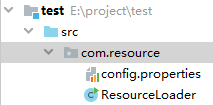本章主要描述 MyBatis 资源加载模块中的 ClassLoaderWrapper 类和 Java 加载配置文件的三种方式。
ClassLoaderWrapper
上一章的案例,使用 org.apache.ibatis.io.Resources#getResourceAsStream(java.lang.String) 方法加载 MyBatis 的配置文件。Resources 是一个提供了多个静态方法的工具类,内部封装了 ClassLoaderWrapper 类的静态字段,Resources 提供的方法都是在 ClassLoaderWrapper 对象中实现的。
ClassLoaderWrapper 主要提供了三类方法:classForName() 方法、getResourceAsStream() 方法、getResourceAsURL() 方法,这三个方法都有多个重载。这里以 getResourceAsStream() 方法为例进行介绍。
org.apache.ibatis.io.ClassLoaderWrapper#getResourceAsStream(java.lang.String, java.lang.ClassLoader[]) 方法源码如下:
public InputStream getResourceAsStream(String resource, ClassLoader classLoader) {return getResourceAsStream(resource, getClassLoaders(classLoader));}// 该方法返回ClassLoader[]数组,该数组指明了类加载器的使用顺序ClassLoader[] getClassLoaders(ClassLoader classLoader) {return new ClassLoader[]{classLoader,// 参数指定的类加载器defaultClassLoader,// 类中指定的默认类加载器Thread.currentThread().getContextClassLoader(),// 当前线程绑定的类加载器getClass().getClassLoader(),// 加载当前类所使用的类加载器systemClassLoader};// 系统类加载器}InputStream getResourceAsStream(String resource, ClassLoader[] classLoader) {// 遍历ClassLoader数组for (ClassLoader cl : classLoader) {if (null != cl) {// 调用ClassLoader.getResourceAsStream方法加载指定的资源InputStream returnValue = cl.getResourceAsStream(resource);// 尝试以“/”开头,再次查找if (null == returnValue) {returnValue = cl.getResourceAsStream("/" + resource);}if (null != returnValue) {return returnValue;}}}return null;}
getResourceAsStream() 方法本质还是使用 Java 类加载器的方式加载配置文件。
Java 加载配置文件的三种方式
项目结构是普通的 Java 项目,非 Maven 项目。如果是 Maven 项目,配置文件会放在 resources 目录下,打成 jar 文件后,配置文件会存在 classpath 根目录下,所以一般使用类加载器的方式加载配置文件。
以下内容转载自:《Java中加载配置文件的三种方式》
配置文件放置位置如下图所示:

1. 通过文件路径加载
/*** 通过文件路径加载** @throws Exception*/public static void loadByFilePath() {InputStream in = null;try {in = new FileInputStream("E:/project/test/src/com/resource/config.properties");Properties props = new Properties();props.load(in);String host = props.getProperty("host");System.out.println(host);} catch (Exception e) {e.printStackTrace();} finally {if (in != null) {try {in.close();} catch (IOException e) {e.printStackTrace();}}}}
FileInputStream 中的参数是配置文件的真实路径。
2. 通过的 Class 的 getResourceAsStream 进行加载
采用相对路径的方式:
**
/*** 通过的 Class 的 getResourceAsStream 进行加载,相对路径*/public static void loadByClassRelativePath() {InputStream in = null;try {in = ResourceLoader.class.getResourceAsStream("config.properties");Properties props = new Properties();props.load(in);String host = props.getProperty("host");System.out.println(host);} catch (Exception e) {e.printStackTrace();} finally {if (in != null) {try {in.close();} catch (IOException e) {e.printStackTrace();}}}}
采用绝对路径的方式:
/*** 通过的 Class 的 getResourceAsStream 进行加载,绝对路径*/public static void loadByClassAbsolutePath() {InputStream in = null;try {in = ResourceLoader.class.getResourceAsStream("/com/resource/config.properties");Properties props = new Properties();props.load(in);String host = props.getProperty("host");System.out.println(host);} catch (Exception e) {e.printStackTrace();} finally {if (in != null) {try {in.close();} catch (IOException e) {e.printStackTrace();}}}}
3. 通过类加载器的方式进行加载
/*** 通过类加载器的方式进行加载*/public static void loadByClassLoader() {InputStream in = null;try {// ClassLoader会在classpath所在的根目录下查找文件// 注意:目录最前面不要加 /in = ResourceLoader.class.getClassLoader().getResourceAsStream("com/resource/config.properties");Properties props = new Properties();props.load(in);String host = props.getProperty("host");System.out.println(host);} catch (Exception e) {e.printStackTrace();} finally {if (in != null) {try {in.close();} catch (IOException e) {e.printStackTrace();}}}}
作者:殷建卫 链接:https://www.yuque.com/yinjianwei/vyrvkf/brms22 来源:殷建卫 - 架构笔记 著作权归作者所有。商业转载请联系作者获得授权,非商业转载请注明出处。

